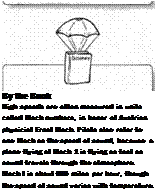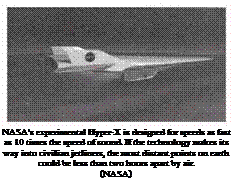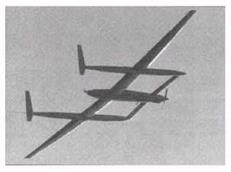Skunking the Competition
Burt Rutan has become the Master Designer in his own desert Skunk Works. Rutan revolutionized airplane design, and he leaves a stylistic mark on his airplanes as recognizable as the architectural flourishes of Frank Lloyd Wright.
Most of his airplane designs include a canard in front of the craft and a pusher prop or a jet engine either on the back of the wing or behind the fuselage. Rutan’s designs typically throw the idea of a rudder out the window and replace it with a number of smaller vertical surfaces spread around the airplane, from turned-up wingtips to twin stabilizers stuck out at the two ends of a horizontal stabilizer.
In the 1970s, Rutan designed a series of small, kitbuilt planes called VariEze, Quickie, and Long-EZ. These speedy experimental planes with outlandish designs quickly began turning up at airports around the country, and with relatively tiny engines, they were outracing other beefier, higher-horsepower conventional airplanes.
Around the World on One Tank of Gas
Rutan cemented his reputation in aviation history, and earned a spot in the International Aerospace Hall of Fame, with his design of the Voyager, the skinnywinged, ungainly looking “flying fuel tank” of an airplane that flew around the globe without stopping for gas.
|
|
Plane Talk
Voyager was piloted by the team of Jeana Yeager and Dick Rutan, the designer’s brash and charismatic brother. Not long after Voyage/$ around-the-world flight, I happened one day to be flying into Ernest A. Love Field in Prescott, Arizona, at the same time as Dick Rutan. Throwing radio etiquette to the wind just as his brother ignores the conventions of plane design, Dick Rutan announced his presence on the radio to those of us who were also approaching Prescott. Rather than resort to the time-honored tradition of announcing his presence by referring to his airplane’s registration number, as pilots have been doing since airplanes first got radios, the Voyager pilot keyed his mike and announced to the handful of us on the control tower frequency, "This is Dick Rutan, inbound for landing!"
. – . ■ ——————————- —і——— і———————————————————————— і————-
In December 1986, Voyager lifted off from Mojave, California, in an attempt to do what no one considered remotely possible: fly some 25,000 miles, the circumference of the globe, on a single tank of gas. But what a tank it was! Rutan created an airplane so light and so strong that it was capable of carrying 10 times its own weight in fuel, crew, and cargo. Pilots Jeana Yeager (no relation to Chuck) and Dick Rutan, Burt’s brother, kept cargo to a minimum in their cramped crew quarters so that fuel would make up most of the remaining weight.
|
|
Designed by Burt Rutan and piloted by Jeana Yeager and
Dick Rutan, the Voyager flew around the world in nine
days on a single tank of gas.
(NASA)
The flight was snake-bit from the outset. One of Voyager’s wings scraped the runway on takeoff, badly damaging a wingtip and causing a winglet to fall off. Worse, an autopilot, which Burt Rutan had installed in order to tame the wild oscillations of the inherently jittery airplane, failed early in the flight, making controlling the airplane difficult and tiring for the two pilots. But, fortunately, these problems didn’t endanger the flight.
After nine days, Voyager touched down again in Mojave, having doubled the previous record for the longest nonstop flight without refueling, logging 28,000 miles.
 |
 |
Rutan is still turning out some remarkable designs, including the Boomerang, which defies the “rules” of design symmetry by creating a lopsided airplane with two fuselages and two engines, and seemingly only half a horizontal stabilizer. Unorthodox as it is, it’s one of the most strikingly beautiful airplane designs I’ve ever seen, something like an airborne version of the Guggenheim museum.
Jetting into the Future
Designers like MacCready and Rutan continue to draw the future of aviation on their drafting tables, creating aircraft that fly faster, higher, and even to the edge of space.
NASA is hard at work developing a line of X-planes that will carry people and cargo to altitudes that we only dreamed of a few years ago.
At Langley Research Center in Hampton, Virginia, designers and engineers are ready to launch a prototype of a hypersonic jet called Hyper-X. The Hyper-X is designed to fly at a speed of Mach 10, or 6,600 miles an hour, using an experimental “scramjet.”
A scramjet, for “supersonic combustion ramjet,” is a jet engine that has no moving parts. Air passes through the engine at supersonic speed, is mixed with fuel, and the mixture is then burned to create thrust. It’s expected that the scramjet engine will be able to push future aircraft to speeds of about two miles per
second, or more than 7,000 miles per hour, as compared to 500 m. p.h. that is typical for passenger jets.
Whether they are scramjets or conventional jet engines, called “turbofans” in their most common form, jet engines compress air using a series of fast – spinning fanlike rotors contained inside a shroud that keeps the air from escaping once it starts to move through the engine. Once the air is compressed, fuel, usually kerosene, is sprayed into the dense air in a precise ratio.
The fuel – air mixture moves into a combustion chamber, where spark plug – like igniters cause the volatile mixture to explode. The heat and outward pressure of the explosion pushes on all sides of the combustion chamber, which is simply a cylinder with an exhaust opening at one end.
The pressure of the burning fuel-air mixture exerts a powerful force on every surface inside the combustion chamber including the front of the chamber, where in obedience to Isaac Newton’s law of physics that says “every action produces an equal and opposite reaction,” the combustion chamber receives a forward impulse. Because the engine is part of the plane, the impulse created inside the combustion chamber delivers a forward jolt to the entire airplane.
|
On Course Sometime in 2000, a group of human-powered airplane junkies will tjy to break a distance record in the pedal-powered Raven, which is being designed and tested in Seattle, The 90-pound craft, whose 115-foot wingspan is wider than a 737’s, will fly from Vancouver to Seattle, skimming over the waves of Puget Sound at an altitude of 18 feet. The project has been underway for more than 10 years. |
Once the volatile fuel-air mixture is ignited and delivers its thrust force, the spent exhaust gases rush out of the engine through the exhaust nozzle. But before the fuelair mixture leaves the engine, it races past another set of fanlike rotors, called “turbines,” set in the exhaust path. The force of the exhaust turns the turbines, which are connected via an axle to the compressors at the front of the engine, where the process began.
In other words, the force of the exhaust gas is harnessed to spin the compressor fans, creating a simple and self-perpetuating cycle that continues as long as the fuel and the ignition spark last.
Scramjets function in much the same way, except that the incredibly high speed of aircraft like the X-34 causes the air entering the engine to compress naturally. That means a scramjet has no need for compressor fans, not to mention the turbine fans to turn the compressor. The fuel system simply injects fuel into the compressed air, then ignites the mixture. In a scramjet operating at full speed, the airflow through the combustion chamber never drops below the Mach 1.
If NASA is successful at spinning off its technology into the private sector, we could one day be flying in airplanes that don’t make any flights of more than two hours in length. After all, a trip halfway around
 |
In aircraft traveling at speeds of Mach 3 to Mach 10 or more, travel would be revolutionized. For one thing, it will become far more expensive as scramjets and their kin evolve to power progressively larger jetliners. What could result is a class division even more stark than the one that separates first-class passengers from those in coach class: Wealthy travelers will enjoy the luxury of hypersonic speeds while others will settle for more sluggish 600-m. p.h. flights.
On board a hypersonic passenger jet, comfort and amenities will be less critical on a flight that is likely to take only 60 to 90 minutes. Today, when flights can drag on for 10 hours or more, comfort and entertainment are paramount. The hypersonic jets of the future will be technologically advanced, probably equipped with wireless communications and data links that are unimaginable today, but will not need to address the creature comforts that travelers consider of the new millennium so important.
 |
But just as when airline travel gradually overtook rail travel during the 1950s and 1960s, hypersonic travel might spread to all classes of travelers as technology advances and fares drop. By 2030, virtually all travelers should be able to afford the price of a hypersonic flight across the country or around the world. At such speeds, many flights will be too brief for an airline meal—just one more advantage of the hypersonic age.














